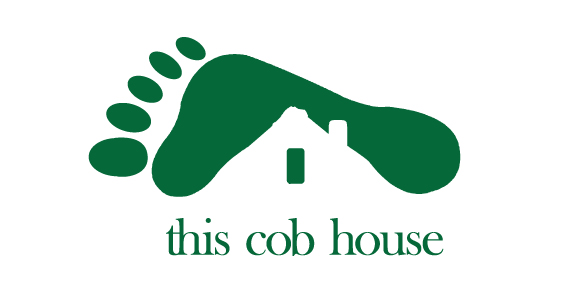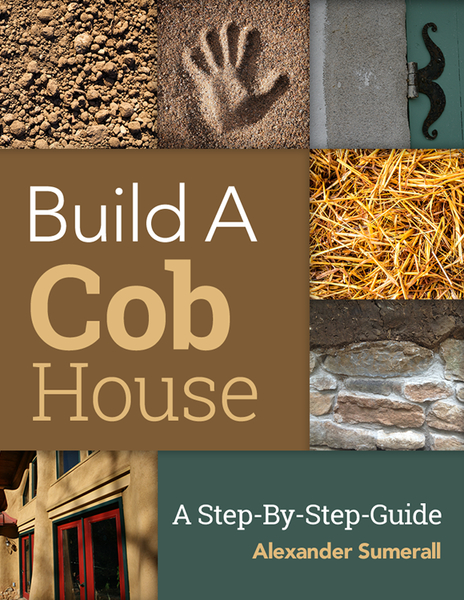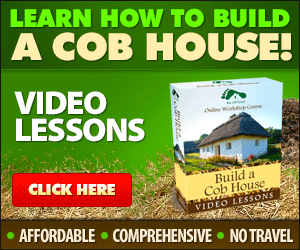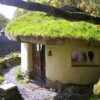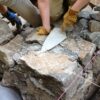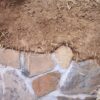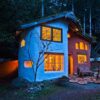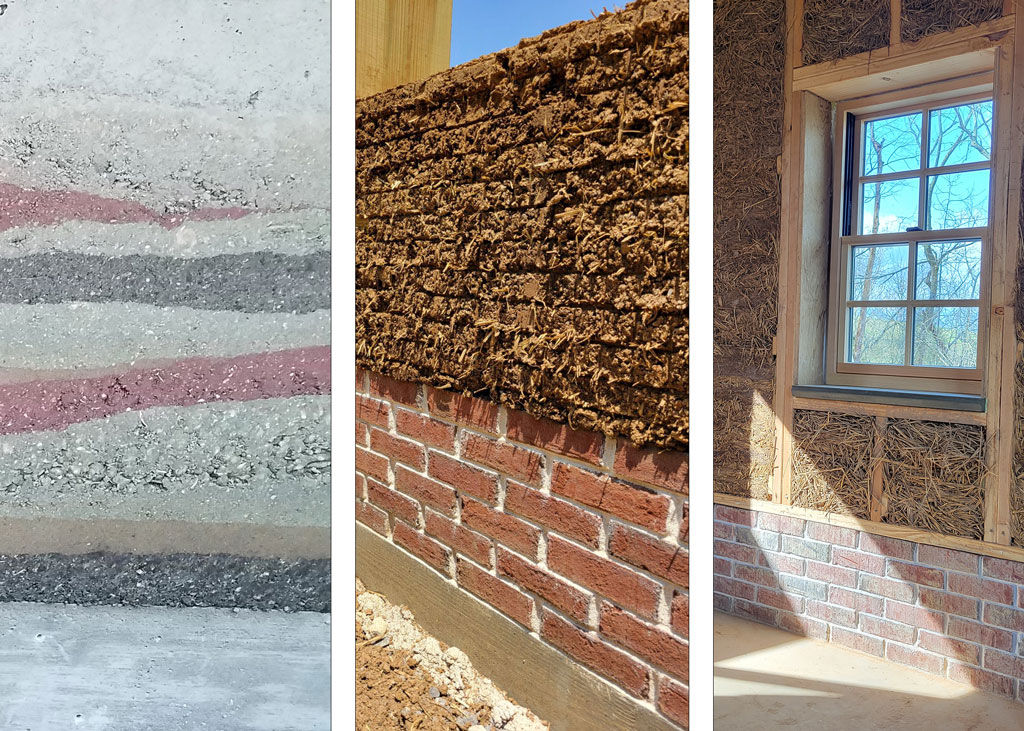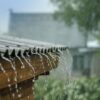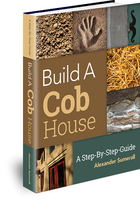Modern Cob House Design 101 is a video presentation I put together on the main components and principles of designing a cob or earthen home for the standards of the 21st century. This is a value packed video for beginners and for experts.
Here are the topics that I cover in this video presentation on modern cob house design:
- Who can benefit from a cob house? How can you benefit?
- Properties of cob buildings
- Climate options/Hybrid designs for cold climates
- Can cob homes work in cold climates?
- Conventional methods and natural building combination
- Components of cob building design: foundation, drainage, plaster, roof, etc.
- Weatherproofing a cob building
- How large can a cob building be? Costs.
- What’s the future for cob?
- Building a Cob House – Checklist
- Design Masterclass
Video Transcript
Hi!
And welcome to this webinar presentation.
My name is Alexander Sumerall
Founder and teacher at This Cob House
My company that I began in 2011 to help educate people on the use of earth as a building material.
This presentation will run about 30 minutes long.
And I created it for you as a way to learn about elements of designing a cob house.
Because I believe…
A point that is lacking in our Natural Building community is the study and importance of good design.
The recent Natural Building phenomena in North America has been mostly a grassroots movement.
With little to no oversight in regards to design or compliance to building guidelines.
This presentation isn’t going to speak on the pros and cons of this.
But rather, will be a means of furthering our education in strong design concepts for those of us who do want to build to codes and guidelines.
If we want there to be a future for cob and earthen construction
Then I believe we need to build to the standards set by our society.
Not to discount the creative and innovative aspects of earth building…
But to combine the best of both worlds.
Modern construction technologies
With traditional materials that make sense for us and the planet.
So, let’s get started by asking the question…
Who can benefit from having a cob house?
We are still a long ways away from seeing cob, and earth materials, used as a standard conventional material for building construction.
This will take time and proven results to replace some of our conventional building methods.
But the point is not to replace everything we have now with cob.
Cob is appropriate for certain types of buildings, and our standard conventional materials are appropriate for certain types of buildings too.
We just need to be using the right material for the situation.
Cob, as well as other earthen building materials, are appropriate based on a number of variables.
Three of the main ones being: climate, zoning, and purpose of use.
Earth buildings have proven themselves appropriate throughout the world. The only real issue I see is their lack of insulation for very cold climates. I’ll touch more on this later and offer some solutions.
Cob still doesn’t have an official building code and is not normally allowed in city limits.
Though it could be appropriate for urban or suburban areas if allowed and built right.
Cob is appropriate for all types of buildings. Small or large. It is very labor intensive, and would not be appropriate for such large buildings as movie theaters, shopping malls, and other large building complexes like that.
These would be instances for other earth materials such as adobe or rammed earth.
Or to just use our conventional modern materials if they make the most sense.
Now…
Getting down to it.
I think you will most benefit from a cob home if you fit into one or more of these categories:
- Want to live more self-sustainably
- Want to reduce environmental footprint
- Want to live in a healthier environment or if you have chemical sensitivities
- Want to have all the benefits that earth building can provide
So…
Lets look now at some of the inherent properties of earth building materials that can provide us benefits.
Interior Temperature Regulation
Soil from the earth has proven to be a very suitable and successful building material throughout the world’s many climates because of its ability to regulate indoor temperatures.
Earth is a poor conductor of heat, has low thermal conductivity, and has high thermal mass.
Basically, this means that cob walls can actually store and release heat to regulate the indoor air temperature.
This is going to make your home much more energy efficient, and can cut down drastically on your electrical needs if designed right.
Humidity Regulation
Keeping a balanced level of indoor humidity is important to maintaining a healthy living environment and preventing mold and fungus growth inside.
Unlike all other natural and conventional building materials, earth has the ability to balance indoor humidity levels.
Earth materials, which are porous, have the ability to absorb humidity from the air and to release it back into the air.
This results in a balance of indoor humidity.
In this way, earth walls act as a natural indoor humidity regulator.
Flexibility and Strength
When dry, cob buildings are extremely strong and durable resembling that of stone or concrete.
Fortifications used to be made with cob and similar earthen materials because they were so strong. Bullets can barely penetrate a thick earthen wall and they are nearly impossible to dig through.
Cob homes are very solid and resistant to earthquakes when build on a proper foundation.
Many cob homes have also lasted for hundreds of years with minimal upkeep, whereas wooden structures generally survive only a few generations.
If you build it right, a cob home will last for many many generations.
Healthier Living Environment
Unlike conventional homes which are constructed with synthetic, industrial-formed materials, cob homes use more natural, clean materials.
Industrial homes are full of indoor air pollutants and off-gassing of chemicals contained in many of the common building materials.
Cob homes replace all of the toxic materials used in the walls of a conventional building.
In fact, cob actually “breathes” through its tiny pores and keeps air fresh and clear. If you suffer from indoor allergies then living in a cob house could significantly improve your quality of life by eliminating the toxins that may cause them.
Earth buildings are a good option for those who suffer from allergies or chemical sensitivities.
Acoustic Privacy
Earthen walls have very good sound-absorbing properties that keep it quiet inside, both from exterior noises and noise generated in the same building.
Termite Proof
Since cob is a mixture of soil, aggregate sand, and straw it is not attractive to termites. To add to that, cob homes have not been known to become burrowing grounds for insects or animals either as long as the house is generally maintained.
Fire Proof
Cob does not catch fire.
However, still be aware of your ceiling or roof as it might not be flame resistant like the body of the house.
Now…
Lets venture into the topic of…
Climate
One of the most frequently asked questions raised about cob buildings is…
What types of climates can they be built in?
So…
The resources for cob, or other earth building materials…
Can be found across the whole earth.
Except for a few exceptions.
These would include places where the soil is just too sandy, or doesn’t have enough clay content.
There are usually alternatives to common straw too…
If that is not local to your area.
So, the main environmental factor that could prevent cob from being valid somewhere…
Would be the climate conditions.
Earth materials perform well in all climates except for ones that have very cold winters.
And there may be other exceptions that I’m not aware of, but this is generally the case.
Its important to understand that…
Earth materials lack any significant insulation value.
Therefore, you either have to make up for it by adding insulation…
Or relying on the thermal mass of the earth materials, passive solar design, and indoor heating.
Lack of insulation should not rule out cob as a valid building material in cold climates though.
Proper design will determine your comfort in a cold climate.
Another option is to create a hybrid structure.
This is simply a building with walls made out of various materials.
For example, its common to build a cob-strawbale hybrid building in northern climates.
The strawbale provides high insulation on the coldest sides of the building.
While the cob walls take advantage of their thermal mass properties on the sides of the building receiving the most direct sunlight.
So, overall…
Cob is suitable for most climates.
We’re not talking about a small niche climate range here…
In terms of where we can successfully build with cob and earth materials.
Traditional and Conventional Materials
People have used earth as a building material for thousands of years…
Because it works very well for the purpose, and is locally available.
Now…
I don’t come from a purist type of mindset.
That Natural Builders should never use any modern building materials.
I believe we can achieve the most by incorporating the best of both sides of the spectrum.
To use modern building materials where they are appropriate and make the most sense.
And to use earth materials, or natural materials, where they are appropriate and make the most sense.
This way you get the most advantages out of your building’s materials.
It also paves the way for more acceptance of earth building in the modernized world.
Okay…
Now, I’ll talk about the main components of a cob house.
And these components apply to almost any type of house or building.
Of course,
We start with the…
Foundation
And the foundation is the solid base upon which your building rests.
No building will be strong and stable unless the foundation is first.
I’ve seen to many cob buildings with very poor foundations.
And that’s why I’m going to stress the point…
That you need a good foundation.
Don’t skimp on the foundation.
This should be one of the most time-intensive parts of your building project, in my opinion.
The design, planning, and construction of the foundation is a huge part.
And this is why I advocate mostly for modern conventional foundations…
When building any kind of building.
Traditional and alternative methods have a lot more room for error or are just not up to quality standards sometimes.
In my cob house designs, I now always implement a concrete foundation.
This will provide a solid footing and stem wall.
It will also pass codes…
So you can get through on that step.
And…
A good foundation also needs a proper drainage system.
Since water is especially damaging to dry cob walls.
This is another aspect of a foundation that needs to be designed right.
With a good strategy for collecting and diverting water away from the building.
This is normally done with gravel trenches and drain pipes around the perimeter of the building and underneath the foundation.
Roof gutters and spouts directed away from the building are also good to have.
Now…
Moving right along…
On top of the foundation go the cob walls.
And of course, the windows and doors get built into the cob walls as the walls rise in height.
There are many variations of how to install windows and doors into cob.
Normally, they are set into a wooden frame…
And then the frame is attached to the cob wall by pieces usually termed as “deadmen.”
These “deadmen” act as anchors as they’re completely embedded inside the cob walls.
And then the windows or doors are drilled to these embedded anchors.
So now…
Once you reach the top of the cob walls…
Whatever height that they need to be.
This is where I encourage the use of a bond beam.
The bond beam is the point of attachment for the roof of the building.
It has anchor bolts embedded into it, which are used for attaching the top plate.
The top plate is what the roof is then attached to.
And the bond beam also acts as a tension ring that ties all of the walls together into one monolithic piece.
A bond beam creates a stronger wall system and its good for earthquake prone areas as well.
The roof can also help tie the walls together by it strength and connection to the bond beam.
This creates a uniform distribution of earthquake loads onto all of the walls of the building rather than just to those which are perpendicular to the direction of the ground movement.
So…
The bond beam is also made of concrete and reinforced with rebar.
So…
You get a stronger building, and an easy way to attach your roofing.
Yes, it’s a bit more concrete, but I do believe its worth it.
Concrete bond beams are very common on rammed earth buildings.
Again, another helpful way to hopefully get building approval, if you’re going that route.
Next…
I’ll touch on the subject of electrical and water lines
In regards to cob buildings.
And these concepts apply to earth buildings in general too.
Water lines should never be run inside of cob walls.
Its just too much of a risk.
A broken and leaky pipe will be disaster for any earthen wall.
That’s why I recommend running water lines in and out underneath or through the foundation…
And then running water lines underneath the floor to get to various parts of the building.
Electrical lines are different though.
These can be run through cob walls.
Since cob is not going to catch fire.
That is not a risk.
I recommend running electrical wires into cob walls through metal conduits.
This makes it easier to feed wire through the wall and repair any wires later on.
And so…
Now that we’ve covered these basic building components…
That leaves the roof as the other big piece.
And the roof is made a lot easier if we just use the modern bond beam.
The concrete beam that sits on top of the cob walls.
From this point…
All you do is build a conventional style roof.
With regular conventional materials.
And it attaches right on the level bond beam.
Now…
This might not seem like a great idea or very innovative.
But its actually the best way to attach a roof, in my opinion.
There are many methods that people have developed for attaching the roof.
But they’re more difficult to construct, not as strong, and less code-friendly.
They also add to the learning curve for new builders.
For example, some cob builders advocate running the rafters through the cob walls.
But this really creates a nightmare for roof building.
I just as well advise you not to try that route.
Add a proper bond beam, then you can simply attach any kind of roof you want.
Using normal building methods.
No extra learning curves or difficulties involved this way.
Okay…
So, the roof is obviously important for keeping the house dry.
And that’s what I’ll speak on next.
How to weatherproof and keep the cob walls dry.
As far as the roof goes…
It basically needs to have overhangs on the sides to protect the walls from rainfall.
The other ways are, again to have a good drainage system around the building and foundation.
To collect and divert water runoff away.
And the third main part…
Is to have an exterior finish on the cob walls.
This render acts kind of like a skin of protection from moisture damage.
Alright.
So, now that we’ve looked at the building components…
Let’s turn our attention to another frequently asked question.
And the question is…
How big can a cob house be?
So technically, a cob house can be as large as can be imagined.
Though cob does have some restrictions on height…for the average builder.
But in terms of normal house sizes these days.
Yes, anything is possible within that spectrum, really.
But the size of your house or building is going to depend on a whole list of variables.
As with deciding the size of any kind of building.
And the same goes for cost.
There is no way to say how much a cob house, so many square feet will cost to build…
Because there are just far too many variables involved.
Somebody could build a 1000 square foot cob house for 30,000 dollars.
And another person could build a 1000 square foot cob house for 300,000 dollars.
Costs will depend on things such as…
Labor costs
Quality of materials
Style of building
Inspections
Whether you have architects and engineers involved
Meeting certain regulations
Just to name a few…
So…
Now, with all of this said and done.
What does the future hold for cob and earthen building methods?
And…
I personally believe that with the direction that things are going.
Cob. And when I say cob here, I mean earthen building in general, really…
Cob has a big place in the future of building.
For starters…
Its and environmentally conscious building material
Its more economical
And it’s a healthy alternative to toxic industrially-produced materials that we normally use today.
But despite the overwhelming advantages of such a material as earth.
There is still a tremendous amount of work and scientific testing that will have to happen before it can take its place as a mainstream building technique.
For example…
Soil is different everywhere.
This is a nightmare to try and standardize and conform a system to.
And it can take a keen sense of the soil composition and testing to determine if its suitable for building with sometimes.
Official building codes will have to be established as well.
This takes lots of money and time.
However…
Cob is available for us now.
Despite the restrictions that can occur.
And we still get to be the pioneers in this story.
That’s one of the main goals with my business, This Cob House…
Is to try and show by example what’s possible with earth materials…
For the average person.
I also want to bridge the gap between traditional earthen materials and modern conventional materials.
I believe they do create a perfect marriage together…
In order to create modern, stylistic, clean, healthy, and harmonious buildings that will stand strong through many generations.
…
Alright.
Now I’ll take you through a basic checklist for building a cob home.
So, building a home is a major undertaking that will cost you a lot of money and time.
It can be like putting together a large three dimensional puzzle that has to also be able to interact with the environment and the conditions around it.
Building a home is also a lot of hard work, both physically and mentally, and will require you to use a variety of skills.
So, the more skills and knowledge that you bring to the table the fewer learning curves you will have to overcome, but there will always be challenges and complications.
Another thing is…
You will also have to learn to work with others throughout your building process.
Even if you build your home by yourself, you might still have to work with designers, structural engineers, and building inspectors.
Or just your friends helping you.
Next is to…
Develop a Vision.
Set a vision for what you ultimately want to achieve with your building.
Only you can know what you want, but it’s a good idea to think logically and realistically when deciding what you want to build.
A lot of people’s ideas become very extravagant and out of proportion with what they can realistically accomplish.
So, its important to keep it real.
And next is…
Site Selection
The site that you choose for your building can have a large influence on how efficient it is and how it will be preserved over time.
There are many aspects to consider for selecting a proper site, which this presentation won’t be covering, but you need to find a good site before you can put together a detailed design plan.
The site can strongly influence the design and function of your building.
Next is to…
Estimate Costs
Be realistic and conservative in your cost estimates.
At least, that’s what I do for my projects because it almost always turns out to consume more time and money than I originally planned for.
The ingredients for cob are cheap, but account for everything that you will need.
Foundation materials, roofing materials, windows, doors, electrical, plumbing, tools, machinery, transportation, subcontractors, permits, etc.
They all cost a lot of money when added up.
So, don’t lose sight of reality and expect to build your cob home on the cheap just because the walls are made of cob.
And next, of course is…
Design
Designing a building is an art and a science in itself.
The way that you lay out the floor plan for your building will be what you have to live with once the building is built.
So, put intelligent thought into your design.
You may want to consult with a professional builder or interior designer before going forward with your plans.
They can help pick out the faults in your design and offer valuable solutions for you.
And this next one’s important too…
Planning and Timetable
Make a game plan for your project, and set a timetable for building your structure.
You should plan out each phase of the building process according to the seasons, your financial situation, and materials availability.
For example, you might not have enough money to complete the whole project at the start, but you do have enough to build the foundation.
So, you might plan to build your foundation during the winter while its cold and unsuitable for cob building, save money during that phase, and then be ready to do the cob work when it warms up in the spring time and have money for the next phase.
And then the last and one of the most important points in the checklist is…
Education
You need to begin to thoroughly educate yourself on building with cob or whatever type of building you are going for.
Whether you’re building it yourself or having somebody else do it for you, you need to know how everything works and integrates together.
You can never get enough education about building.
But at some point you are going to have to start if you want to have a house.
However, I would recommend more education and learning experience rather than rushing into any building project.
It may take you a few more years of preparation before constructing your dream home, but it can be well worth it.
Start reading books on cob, natural building, sustainable energy systems, and whatever else interests you for putting together a home.
You might have to learn a whole new set of skills.
Also try to take classes and workshops to gain confidence with these new skills.
I really can’t stress the education and learning enough.
That’s why I put so much work into creating these educational webinars, writing articles, books, and making videos.
I want people to have the knowledge and understanding to build with cob.
Without going through all the hoops and learning curves that I did.
And one of the places that I see people having the most trouble with is in design.
So, that’s why I’ve recently put together a design course for you focused entirely on cob building.
And this is your chance to get access to this new course.
So, in a nutshell…
This course will teach you how to design a modern, high standard, more code-friendly cob house.
No other workshop, book, or video anywhere else has laid out the fundamentals of cob design like this new course does.
I really think it’s a unique opportunity.
You won’t get this much design information even if you took ten cob workshops.
So…
This class is delivered in an online format.
And you will receive all of the learning materials as soon as you join.
And the class is composed of these parts:
Video Lessons – You can watch the instructional videos leading you through each design component.
Construction Diagrams – You will get over 100 pages of carefully detailed construction diagrams.
Design Notes – You can also download the notes associated with each lesson for even more design specifications.
And lastly, you can receive the Tiny Cob House Plans. These include 30 extra design diagrams. And whether you even want to build the Tiny House, these designs are a wealth of knowledge that you can learn from to design your own building.
And more specifically…
Here are the building components that you will learn about in the course…
Learn how to build a strong foundation with proper drainage that can meet building codes.
Learn how to integrate electrical and plumbing lines through a cob building.
Learn how to securely install windows and doors into cob walls.
Learn how to form a bond beam to connect your roof and tie your walls together.
Learn how to integrate a second story floor system into a cob building.
Learn how a roof is structured and attached to a cob building.
And learn how to build a tiny cob house!
So…
A little bit more about the tiny cob house plans…
You will get the detailed building plans for this 12′ x 24′ cob house.
And whether you want to build this structure or not, the plans are a wealth of information for building any cob building.
The plans include 30 extra pages of building diagrams.
And you will also receive the SketchUp file so you can explore and edit the model.
These building plans include everything you need to construct this building.
Okay.
So, why should you join this course?
And firstly I’ll say that…
If you have an interest in building a cob house (or any kind of house) then this is definitely the course for you.
While this course is based on using cob…
These design lessons apply to many other Natural Building methods, such as:
rammed earth, adobe, earthbag, straw bale, and light straw-clay
You won’t learn these important design lessons at any other workshop.
I’ve compiled some of the best design lessons all in one compact course from years of research and experience.
These lessons can literally save you thousands of dollars in building mistakes, and could even save your house from a structural disaster!
An architect or a Natural Building design consultant can cost you hundreds or thousands of dollars for a single visit and consultation.
And not to say that this is bad and that they are overcharging.
Not all all, actually.
One visit by a professional designer might cost you $500 but it could save you $50,000 in mistakes.
And this course has the potential to save you thousands of dollars in the same ways.
Whether you’re working with a professional designer or not, you personally need to understand the fundamentals of designing a cob building.
Here are some of the benefits of doing this course:
- You get access to the ONLY design-focused cob workshop
- You will learn how to avoid the major design mistakes with cob building
- You can potentially save thousands of dollars in architect and consultancy fees
- There is no travel required. All you need is a computer with internet access!
- There’s no need to use your precious vacation days to attend a workshop
- And there’s no need to cut time out of your busy schedule
And as an added bonus…
For signing up for the course from this webinar presentation…
You get both of my eBooks that cover cob building and building codes.
And…
On top of that…
I also want you to know that, because I value you as students and customers, that there is no risk in signing up and purchasing this course.
You are protected by my 30-day, 100% money back guarantee.
If you are not satisfied and, within 30 days of signing up for the class, want a full refund you will be refunded.
I made this program for you! And I’m committed to delivering you with valuable learning content here.
I want you to feel comfortable and satisfied with taking the course.
So…
In just a second here…
I’ll display the link for you to click on..
Where you can join the course.
So, when you click the link
You’ll then be directed to the page where you can select the course package that you want.
Select which pricing option you want…
And then you’ll be directed to the secure Checkout page where you can make your payment via credit card or Paypal.
And then…
Once your payment is made, you’ll receive a confirmation email within a few minutes of processing your order.
This email will include your login information and tell you how to access the materials.
Be sure to check your spam folder if you don’t see it.
Sometimes it goes there instead for some reason.
So, at this point…
If you’d like to join the design course…
Please click the link below and sign up.
Also…
If you have questions about the course…
There is a Frequently Asked Questions section on the page. Just click that same link.
You can also email me at:
Alex AT this cob house DOT com
So…
There we go.
And…
I wanted to keep this webinar a bit shorter than usual.
As I know how precious everyone’s time can be.
So…
I do hope that you all enjoyed the presentation.
And I hope that you’ll take a look at my new design course.
This Cob House is only able to stay active because of active participants.
So, I appreciate every student that I have.
Now…
Until next time.
Wishing you all the best in your building endeavors!
OR whatever it might be…
Permaculture, organic gardening, off-grid homesteading.
Just all around health and freedom.
Because this is what its really all about.
So, to everyone here…
Have a great day…
And I’m…
Signing out.
See you next time!
